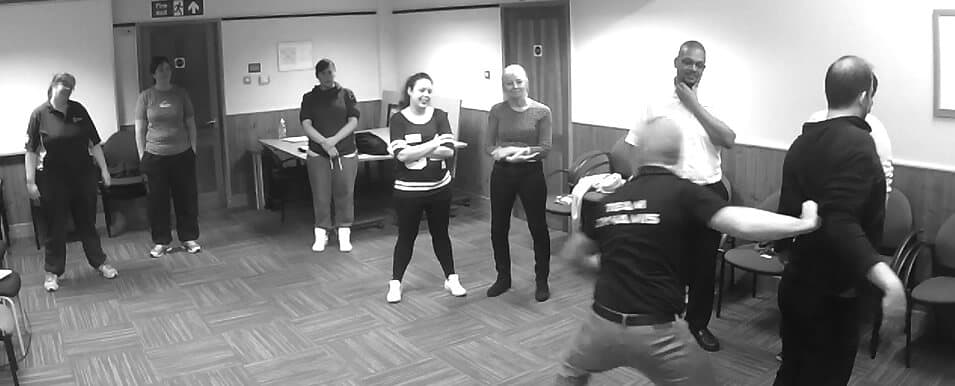Great Lone Worker Safety Devices – are they compatible with the Human Operating System?
— Lone Worker Safety Devices have proliferated in lone worker safety management in the past decade, but are they really useful in the most crucial of moments? How do you call for help as a lone worker?
Our human survival system is extraordinary. It works faster than the ‘plodding of logic’ and can flood our body in an instant with a hormonal cocktail which enables us to achieve Olympian feats of strength, speed and endurance. Your deeply embedded dna-level survival system will always try to protect you in the face of sudden and aggressive threats in close proximity to your body.
The question is, how compatible are the actions needed to activate your personal safety device with the actions genetically wired into your body by millions of years of evolution?Do these effect how you call for help as a lone worker.
The effects of arousal on behaviour, beginning with the Yerkes-Dodson analysis, help us to understand what happens in high-intensity, high-stress moments.
When faced with an imminent threat, as a species of highly successful survivalists, we are wired-up to experience :
- a strong urge to turn our bodies and eyes to face the threat
- perceptual distortion (changes in time-sense, visual field and hearing)
- difficulty in completing tasks requiring cognition (such as negotiating!)
- intense physiological arousal (interpreted as: shakes, nausea, weakness)
…none of which are well-suited to tasks such as:
- staring directly at a number keypad
- forcing attention away from the threat, contrary to what the survival system demands)
- identifying individual numbers on a keypad (while suffering from ‘tunnel vision’)
- using fine-motor control to push a button (while shaking or without fine motor control)
- speaking calmly or slowly, remembering important facts like addresses or names or numbers.
It may even be useful to look again at some of Lt. Col. Dave Grossman’s writing on the subject of physiology and psychology in the critical moment, when we consider the need to call for help as a lone worker:
“….an officer had to apply CPR on his infant daughter. He handed the phone to his wife and told her to dial 911, but she couldn’t do it…she could not see the numbers and she could not use her fingers, even to save her own child’s life”.
In another story, when a woman found someone kicking down her kitchen door to get in her house:
“She fumbled desperately with the telephone but she could not see the numbers. She did manage to press the zero button, which ultimately saved their lives.”
Lt. Col Dave Grossman has stated in regard to tunnel vision that “the more stressed you become, the more narrow the tunnel. There will also be a loss of depth perception, meaning that the threat looks closer than it is, and a loss of near vision, meaning that you have trouble seeing close things. … It is a terrible irony in some stressful situations, that at a time when you need your eyes the most, you may lose your near vision”
Lone Worker Safety Devices and Mumbo Jumbo Number 5
At one of our training sessions, the team had been provided with a system based on the use of mobile phones to make a “Condition Red” call to a dedicated Lone Worker Safety service. The system of work required the person to call for help as a lone worker as follows:
They were to “push and hold the number “5” button on their mobile phone (now updated to the power button SOS call, with a slightly better prognosis) which would put them through to an operator who would immediately begin to record and monitor the worker’s situation, with a view to bringing help to them if needed.
However this particular system of work (to call for help as a lone worker) had serious shortcomings. First, the team had been informed by e-mail that they were responsible for setting up their own phones to call out on the number “5” speed-dial. Quite predictably, the staff team were not 100% compliant in achieving this set-up, which is the first point at which this expensive lone worker safety device ‘system’ was starting to fall over.
The number “5” was chosen because, we have been told, every number “5” on every mobile phone keypad has a raised ‘dot’ area on it which identifies it as the number “5” button.
Sure enough, we find this to be true, even though the prominence and positioning of the 5- dot varies widely. In some cases it is off center, perhaps closer to the top of the button. When we say the top button, we mean when the phone is in an upright position of course…not upside-down inside a pocket or handbag…and perhaps this all assumes you are not using a smartphone whose keypad is a flat touchscreen with a keypad lock on it.
Details, details are important when you call for help as a lone worker!
A proposed experiment for Lone Worker Safety Devices
What would we observe staff to do, in a moment when they are exposed to highly aroused and aggressive individuals who are threatening physical violence to them, to the point where we know they are beginning to experience the physiological effects mentioned above?
We want them to find and press the number 5 button (and only that button, seeing as speed dialling any other number will be ineffective). The worker who is calling for help may or may not be looking directly at the number and must achieve the task with fingers that are numb, shaking and de-sensitised by the action of cortisol and adrenaline in their bloodstream, causing vaso-constriction and robbing them of fine motor control.
They might have to look at the phone….to find the numbers, if their vision allows them to do so.
All the while of course, our “assailant” role player will be applying heat to the system, aggressive, posturing and threatening, continually firing up the worker’s innate survival system, hidden deep within their brain in the tiny and primitive Amygdala fear-centre.
The result is fairly predictable….system-failure in most of the scenarios, dependent largely on the Awareness and Preparedness and Mindset of the workers we might test in this hypothetical experiment.
The better prepared, more aware and more focussed the person on the task immediately to hand, the better they will perform in accessing their lone worker safety device.
There is a concept of ‘Stress Inoculation’ which applies very often to staff in aggressive scenarios – simply put it says that the more experienced someone is in facing a particular type of stressor (such as aggression), the less impact their primal survival responses will have on their behaviour.
Of course, training can provide Stress Inoculation also….however in our experience across many sectors, the emphasis tends to be on “training the kit, not training the person”.
The result being that even highly trained policemen will reach for their kit and put themselves at high risk, rather than reaching out for the person who is presenting the risk in the first place.
In one video we show to our training groups, a policeman whose colleagues are being beaten severely by an offender decides to throw down his baton and instead use another device – CS Spray. He drops his baton and takes one……. Two…… Three…… Four…… Five……. Six seconds to find, unclip, draw, prepare and then deploy the spray on the offender. All the while the situation is still very much out of control and his colleague is being punched and bounced-off the furniture and walls of the room.
In defence of Lone Worker Safety Devices and technology
Our purpose in pointing out the deficiencies we see in training to call for help as a lone worker is not to decry the use of devices completely, but instead to remind the social and health care sector that in the face of real aggression and violence, the person who ultimately holds the final power to influence the outcome of the interaction is the worker themselves.
By their behaviour, their body language, their positioning, their listening and questioning skills, a lone worker’s tactical awareness and their emotional commitment to safety, the worker alone will be able to exert the largest influence on what happens in the client’s front room, hallway, bathroom or bedroom.
Nevertheless, managers have a responsibility to supervise their lone workers in such a way as to control the risks prevalent in their workplace. These safety devices for lone workers do a tremendously helpful job of enabling this to happen in a relatively efficient and cost-effective way, answering questions such as:
- Do my lone worker staff have quick and direct access to call for help if they need it?
- Are the locations of my staff known if we need to find them?
- Have we demonstrably formalised our procedures for dealing with emergencies?
We are positively in favour of the new lone worker technology when:
- it is easy to understand and set-up
- there are clear protocols about how it should be used
- its deployment comes with training in all aspects of lone worker safety
- it is accessible and usable under the conditions of survival-stress
- it is not a replacement for effective risk-assessment and safe systems of work

Gerard O’Dea provides Lone Worker training, personal safety and conflict communications courses for organisations across the spectrum of public services. Parking Wardens, Home Care Workers, Car Leasing Debt Recovery teams and Housing or Social Workers all over the UK have learned how to stay safer in his Lone Worker Personal Safety training courses since 2006.
*No lone worker safety devices were harmed in the production of this blog post.
For more information about our Lone Worker training, click here.


